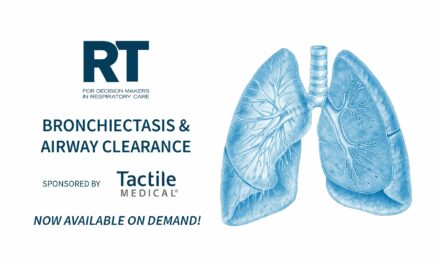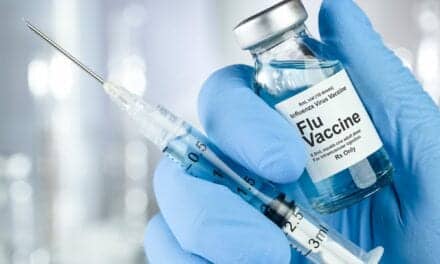Clinicians and manufacturers are looking to a combination of technology, research, and best practices to fight ventilator-associated pneumonia, which, despite progress, continues to afflict thousands of patients every year.
By Phyllis Hanlon
For the last 10 years, the incidence of ventilator-associated pneumonia (VAP) has continued to decline. In 2002, US hospitals reported an estimated 250,000 cases of healthcare-associated pneumonias—36,000 related to deaths, according to the Centers for Disease Control and Prevention. The number of VAP incidents dropped to 3,957 in 2012. In spite of the dramatic reduction, the numbers remain too high and manufacturers and clinicians alike are seeking ways to further reduce VAP.
The CDC defines VAP as a hospital-acquired pneumonia that develops in patients who have been treated with mechanical ventilation for 48 hours or longer, but who had no signs or symptoms of lower respiratory infection before they were intubated and placed on mechanical ventilation. In 2003, the CDC issued guidelines for preventing the incidence of VAP.
Controlling VAP begins with common sense sanitation practices, such as cleaning, sterilizing, and disinfecting device parts, changing filters to prevent cross-contamination and/or exposure to contagious agents in the ICU, and hand washing to reduce the spread of bacteria. Additionally, the CDC recommends elevating the head of the patient bed 35 degrees, routine surveillance via serial chest x-ray, clinical examination and observation, and laboratory findings.
Even though facilities and clinicians endeavor to follow these guidelines, the American Thoracic Society reported that ventilator-associated pneumonia occurs in 9% to 27% of all intubated patients.1 Meanwhile, a study published in the American Journal of Respiratory and Critical Care Medicine indicated that an estimated 5.9% of ICU deaths through day 60 could be attributed to VAP.2 Also of importance, healthcare costs can increase more than $57,000 per incident of VAP.3
A Complex Problem
Thomas J. Wortham, RRT, manager, Clinical Education-Respiratory at Smiths Medical North America, reported that VAP represents a “multifactorial sequence of events and there is a compendium of strategies,” some simple and cost neutral, some complex and cost prohibitive, to reduce the incidence.
For the most part, respiratory therapists and nursing abide by the recommendations from the CDC for cleaning and maintenance of the device. “Insofar as the ventilator is concerned, there are the typical strategies that everyone follows. These include proper filtration of the inspired and expired gases, appropriate ventilator circuit change intervals, reducing the disconnection of the ventilator circuit from the patient, closed suction devices, use of heated wire circuits to reduce condensate, proper handling and manipulation of the circuit to avoid drainage of condensate into the patient, proper use of heat and moisture exchangers and, obviously, appropriate disinfection of the ventilator surfaces between patient use,” Wortham said.
Rather than implicating the ventilator as the root cause of VAP, Wortham suggested that implementing research-based management strategies for ventilation could enhance patient care without the risk of inducing VAP. “More important is how the patient requiring mechanical ventilation is managed. For example, we are now aware that some of the modes of ventilation and parameters under our control may have contributed to VAP. We are adopting lung protection strategies like lower tidal volumes that help reduce inflammatory responses in the lung seen with higher tidal volumes and ventilating pressures,” he said, adding that ventilators that provide feedback can offer valuable information for the clinician.
“Most critical care vents have waveforms that show lung compliance and resistance. Clinicians can use that data to properly manage the patient,” Wortham noted. “We know the artificial airway has a major impact on ventilator-associated pneumonia that has resulted in development of subglottic suction endotracheal and tracheostomy tubes and a continuous cuff pressure monitoring and controlling device.4 Studies indicate that lung protective strategy benefits outweigh the side effects, so we do periodic lung expansion.”
Types of Tubes

The type of endotracheal tube used during ventilation can make a difference in patient care. The Mallinckrodt TaperGuard Evac endotracheal tube from Covidien can be used throughout the course of a patient’s care and provides excellent protection against microaspiration and VAP, according to Gary Milne, BS, RRT, director, Clinical Marketing, Respiratory Solutions, Covidien. “Multiple studies over the past 15 years have consistently shown the benefits of subglottic secretion drainage,” he said. “Mallinckrodt TaperGuard Evac tubes employ the latest in this technology.”
A recent study5 compared another tube—a barrel-shaped cuff with subglottic secretion drainage—to the Mallinckrodt TaperGuard Evac endotracheal tube, which has a taper-shaped cuff with subglottic secretion drainage, and found that the latter may result in improved patient outcomes, shorter hospital stays, and reduced cost of care due to a significant reduction in microaspiration.
Additionally, Milne cited another clinical study6 that investigated the number needed to treat (NNT) and the cost-effectiveness of using subglottic secretion drainage to reduce VAP. The study authors assumed a VAP incidence of 4% and found that using subglottic secretion drainage in 33 patients prevented one episode of VAP, concluding that this strategy was cost-effective in reducing its incidence.
Meanwhile, some clinicians tout the possibility of reducing and preventing VAP with the use of silver coated endotracheal tubes (ET), but these tubes should not be viewed as a “silver bullet” that eliminates the condition, according to Wortham. “Silver coated tubes help reduce the formation of biofilm on the ET tube and silver has some antimicrobial properties.”
He explained that biofilm serves as a normal defense mechanism. “But if something foreign is introduced to the body, it will attach and encapsulate with biofilm, becoming a good surface for bacterial growth,” he noted. In the past, clinicians put saline into the lung prior to suctioning, but washing bacteria growing on biofilm may contribute to the colonization of this bacteria, Wortham pointed out.
Mark L. Metersky, MD, director of the Center for Bronchiectasis Care, Division of Pulmonary and Critical Care Medicine at the University of Connecticut School of Medicine, noted that in spite of reported benefits, silver coated ET tubes are not widely used in ICUs. “The cost benefits ratio depends on the underlying rate of VAP,” he said. “With low incidence, spending money to put [silver coated ET tubes] in every patient doesn’t make sense. Since most ICU rates are coming down, it wouldn’t be a wise investment.” More research is needed to determine if the benefits of using silver coated ET tubes outweigh the costs.
Early Extubation

According to Edwin Coombs, MA, RRT-NPS, ACCS, FAARC, marketing director, North America, Intensive Care and Respiratory Care at Dräger, when mechanical ventilation is unavoidable, early extubation could be key to reducing VAP. Devices with an automated weaning feature that adjusts pressure support based on a patient’s spontaneous respiratory rate, tidal volume, and end-tidal carbon dioxide, such as Dräger’s Evita XL and Evita Infinity V500 (a component of its IACS Workstation Critical Care), enable the clinician to evaluate the patient’s readiness to be extubated. Studies have shown that automated weaning can reduce the time a patient spends on a ventilator.7,8
A patient’s changing medical condition could necessitate that mechanical ventilators be monitored and settings adjusted to accommodate shifts in status. Dräger ventilators incorporate a feature called “Autoflow,” which adjusts pressure during volume ventilation to provide the set tidal volume at the lowest inspiratory pressure possible.
“As a patient’s lung compliance increases, the pressure will decrease to deliver the tidal volume; conversely, if the compliance decreases, the inspiratory pressure will rise incrementally to deliver the set tidal volume,” Coombs explained. “With a properly set volume to minimize or eliminate lung stretch/overdistention and properly set PEEP level to avoid alveolar collapse, pulmonary complications may be avoided.”9
Neonatal Ventilation
Many of the same strategies used during ventilation for the adult patient can be applied to infants and pediatric patients. Mechanical ventilation in neonates, however, presents some unique challenges and draws differing opinions from clinicians. Some manufacturers are addressing these issues in an effort to protect newborns from VAP and other serious complications.
“Typically, today’s ventilators can ventilate small neonates to the largest of patients—2 mL to 2,500 mL of tidal volume can be delivered. The question of taking a ventilator from an adult ICU, where infectious agents are rampant, to a neonatal intensive care is a concern,” said Milne. “Puritan Bennett ventilators offer several configurations from neonatal to pediatric, adult to neonatal, to adult configurations. The software locks out the specific neonatal unit from being used on adults. This is one solution.”
Ventilator-induced lung injury in the NICU poses another serious risk to neonates. Several manufacturers are addressing this problem with lung protective ventilation strategies. The Dräger Babylog VN500 (a component of the IACS Workstation Neonatal Care) incorporates a proximal flow sensor, which monitors and controls breath delivery close to the endotracheal tube.
“Among other values, this allows for measuring and compensating for leakage and correct flow compensation,” said Coombs. “The accuracy of these measurements allows the Babylog VN500 to provide volume ventilation in this patient population, which has been found to be beneficial in terms of limiting lung damage, ensuring stable CO2 levels, and potentially reducing consequent intraventricular hemorrhage.”10
Preventative Strategies
NIV continues to be a popular approach to preventing VAP in some patients, according to Milne. “The use of noninvasive ventilation is one way to reduce the introduction of potential pathogens into the lungs by eliminating the use of artificial airways. Leaks are one challenge with ventilated patients with mask interfaces, and leaks can affect synchrony. Leaks can cause a ventilator to auto-trigger and prolong the duration of inspiration depending on the approach,” he said. “The Puritan Bennett 840 ventilator has a designated NIV option that includes the use of Leak Compensation software to reduce the risk of auto-triggering and delayed cycle.”
Coombs added, “[Dräger] ventilators also have a noninvasive mode of ventilation. If intubation can be avoided through the use of NIV, this too has been shown to reduce VAP/VAE.11 The additional benefit to the RT is that one device, which is a comprehensive workstation, provides any and all various modes of support seamlessly without multiple devices.”
“Sedation vacations” have come into wide use since the publication of a study in the New England Journal of Medicine12 that recommended daily sedation interruptions to reduce duration of mechanical ventilation and length of ICU stay. Wortham pointed out that endotracheal tubes are uncomfortable and patients often don’t tolerate them well, so staff can find it necessary to oversedate. “When you’re sedated, you don’t swallow. The endotracheal tube eliminates glottic function,” he said. “If you withdraw the artificial airway, the patient can be alert and oriented, not as sedated.”
The use of probiotics has recently been explored as another viable option in managing VAP. Lee E. Morrow, MD, MSc, Division of Pulmonary, Critical Care and Sleep Medicine at Creighton University Medical Center in Omaha, Neb, conducted a prospective, randomized, double-blind, placebo-controlled trial13 to evaluate the efficacy of probiotics (Lactobacillus rhamnosus GG) to prevent VAP. His study involved 146 mechanically ventilated patients at risk of VAP. The study group (N = 68) received enteral probiotics and the control group (N = 70) received an inert inulin-based placebo twice a day in addition to routine care.13
The findings showed that patients treated with probiotics were significantly less likely to develop VAP compared with patients treated with placebo (40.0% vs 19.1%; P = 0.007). The study group also had fewer days of antibiotics prescribed for VAP than the control group (8.6 + 10.3 vs 5.6 + 7.8 d; P = 0.05).13
Intubation Alternatives
Obviously, the best way to avoid VAP is not to intubate in the first place. Metersky suggested the use of bi-level positive airway pressure (BiPAP) as a feasible alternative. Since a BiPAP machine uses different levels of air pressure, rather than continuous pressure, this option may address breathing issues effectively.
Metersky also advocates for more attention to oral hygiene. “There is evidence that bacteria in the mouth causes VAP. If you clean the mouth, there will be fewer secretions,” he noted. “You should also avoid gastric acid suppression, which is thought to prevent VAP. When you administer antibiotics, bacteria will flourish.”
A trend toward early mobilization for patients requiring mechanical ventilation is gaining traction in some settings. Patients who remain bedridden become more dependent on a ventilator and experience muscle atrophy. Wortham pointed out that nursing generally tries to get patients up and moving as soon as possible in a progressive manner, from lying in bed to dangling while connected to the equipment to sitting in a chair to ambulating short distances with the ventilator.
“Aggressive physical medicine, including ambulation of ventilator patients, may decrease time on the ventilator and facilitate better outcomes during the weaning process. It is reasonable to suspect that early mobilization may help prevent the onset of VAP,” Wortham noted. “Of course, early mobilization of ventilator patients is labor intensive and not without risks. Smiths Medical has a long history of developing simple to operate, lightweight gas-powered ventilators that help simplify and make safer the practice of early mobilization of ventilator patients. Additionally, appropriate monitoring, including vital signs, capnography, and pulse oximetry, is helpful during mobilization of ventilator patients.”
While ambulation is encouraged in clinical settings, its effectiveness in reducing or preventing VAP is questionable, according to Metersky. “Frankly, if a patient can walk and is stable, they should be in a rehab facility,” he said. “Junk accumulates in the tubing when a patient is moving and can increase the amount of bacteria in the lungs. There’s no evidence that early mobilization helps.”
Wortham noted that there will always be a segment of the patient population that contracts VAP, but, in some cases, respiratory failure and the need for mechanical ventilation, and ultimately the development of VAP, is preventable. “It’s inevitable that patients with comorbid conditions will get VAP,” he said, and asserted that a complex problem like VAP, which unfortunately has a higher incidence in the most critically ill patients requiring mechanical ventilation, should comprise a bundled approach.
“Research needs to continue and we need to rely on our common sense as we continue to care for our patients,” Wortham said. “The challenge of VAP should prompt all caregivers to examine their clinical practices. VAP is not a problem that will be solved by one discipline so there needs to be collaboration. Sometimes doing the little things correctly will add up and help provide good outcomes for our patients.”
RT
Phyllis Hanlon is a contributing writer to RT. For further information, contact [email protected].
References
- American Thoracic Society; Infectious Diseases Society of America. Guidelines for the management of adults with hospital-acquired, ventilator-associated and healthcare-associated pneumonia. Am J Respir Crit Care Med. 2005;171(4):388-416.
- Bekaert M, Timsit JF, Vansteelandt S, et al. Attributable mortality of ventilator-associated pneumonia: a reappraisal using causal analysis. Am J Respir Crit Care Med. 2011;184(10):1133-1139.
- Cocanour CS, Ostrosky-Zeichner L, Peninger M, et al. Cost of a ventilator associated pneumonia in a shock trauma intensive care unit. Surg Infect. 2005;6(1):65-72.
- Coffman HM, Rees CJ, Belafsky PC. Proximal suction tracheotomy tube reduces aspiration volume. Otolaryngol Head Neck Surg. 2008;138(4):441-5.
- Kelley S, Chien HL, Erlson M, Weinmann M. Impact of cuff shape on outcomes of patients intubated with endotracheal tubes with subglottic secretion drainage. Am J Respir Crit Care Med. 2013 Annual Meeting: A2807 (Abstract).
- Kelley SD. Number needed to treat for subglottic secretion drainage technology as a ventilator-associated pneumonia prevention strategy. Crit Care. 2012,16:446.
- Rose L, Schultz MJ, Cardwell CR, et al. Automated versus non-automated weaning for reducing the duration of mechanical ventilation for critically ill adults and children. Cochrane Database Syst Rev. 2013 Jun 6;6:CD990235.
- Burns KE, Meade MO, Lessard MR, et al. Wean earlier and automatically with new technology (the WEAN study): a multicenter, pilot randomized controlled trial. Am J Resp Crit Care Med. 2013;187(11):1203-11.
- Jonson B, Richard JC, Straus C, et al. Pressure-volume curves and compliance in acute lung injury. Am J Respir Crit Care Med. 1999;159(4 Pt 1):1172-1178.
- McCallion N, Davis PG, Morley CJ. Volume-targeted versus pressure-limited ventilation in the neonate. Cochrane Database Syst Rev. 2005;(3)CD003666.
- Bouadma L, Wolff M, Lucet JC. Ventilator-associated pneumonia and its prevention. Curr Opin Infect Dis. 2012;25(4):395-404.
- Kress JP, Pohlman AS, O’Connor MF, Hall JB. Daily interruption of sedative infusions in critically ill patients undergoing mechanical ventilation. N Engl J Med. 2000;342(20):1471-7.
- Morrow LE, Kollef MH, Casale TB. Probiotic prophylaxis of ventilator-associated pneumonia: a blinded, randomized, controlled trial. Am J Respir Crit Care Med. 2010;182(8):1058–1064.










